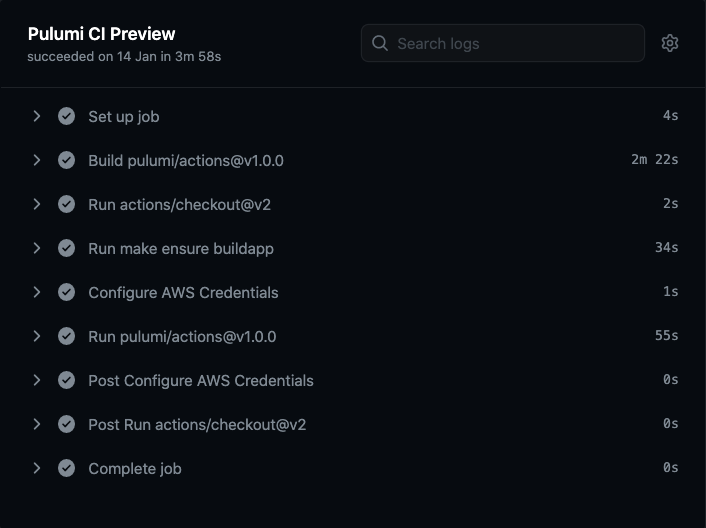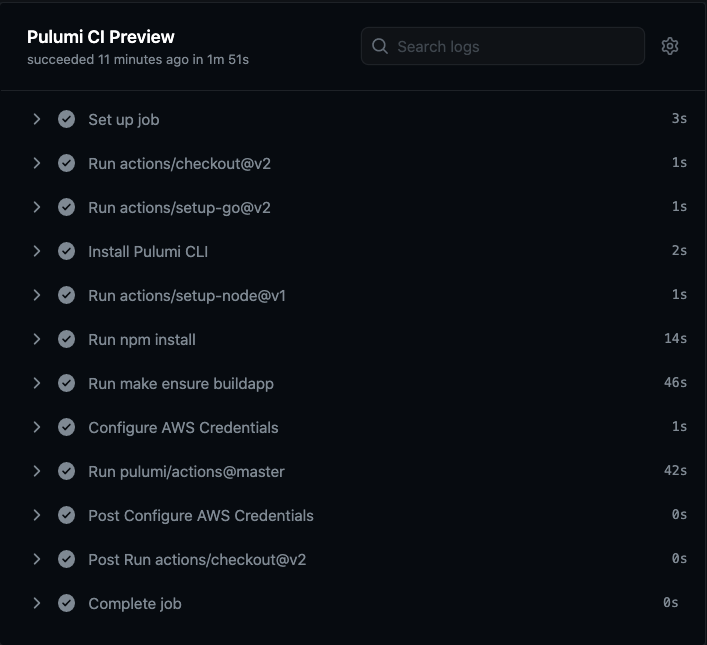Supercharging our GitHub Action with the Automation API
Posted on
Guest Article: Simen A. W. Olsen is a Software Architect and Manager at Bjerk, a software development agency based in Oslo, Norway. He joins Paul Stack to talk about the new GitHub Action powered by the Pulumi Automation API.
In this article, we’ll take a look at how our GitHub Action has been re-architected to be built on top of our Automation API.
As a GitHub Actions launch partner in 2018, we released our original GitHub Action, built as a Docker container action. This Action packaged all the prerequisites with the Pulumi CLI to let users run Pulumi commands. As the Pulumi ecosystem has grown, so too did the container run in GitHub Actions.
Since then, GitHub released an alternative way to create a GitHub Action by writing JavaScript. At Pulumi, and in our community, we love expressing everything we possibly can in code, so the new JavaScript support got us quite excited about the “better together” possibilities! Enter Pulumi’s new Automation API, a new feature we launched in public preview in October 2020. This new capability lets you build infrastructure as code—in pure code—without even needing to run a CLI. This sounded like a perfect match for a JavaScript Action. Creating a JavaScript Action allows us to programmatically invoke the right Pulumi commands in response to actions, without needing to awkwardly script a CLI. Instead, we were able to leverage the Automation API to fundamentally rethink our GitHub Action.
Under the Hood
Let’s take a look at the new JavaScript-based GitHub Action and see how it uses Automation API to execute Pulumi:
const main = async () => {
const config = await makeConfig();
if (environmentVariables.PULUMI_ACCESS_TOKEN !== '') {
await pulumiCli.run('login');
} else if (config.cloudUrl) {
await pulumiCli.run('login', config.cloudUrl);
}
const workDir = resolve(
environmentVariables.GITHUB_WORKSPACE,
config.workDir,
);
const stack = await LocalWorkspace.selectStack({
stackName: config.stackName,
workDir: workDir,
});
const onOutput = (msg: string) => {
.....
};
const actions: Record<Commands, () => Promise<string>> = {
up: () => stack.up({ onOutput }).then((r) => r.stdout),
refresh: () => stack.refresh({ onOutput }).then((r) => r.stdout),
destroy: () => stack.destroy({ onOutput }).then((r) => r.stdout),
preview: async () => {
const { stdout, stderr } = await stack.preview();
onOutput(stdout);
onOutput(stderr);
return stdout;
},
};
const output = await actions[config.command]();
const outputs = await stack.outputs();
for (const [outKey, outExport] of Object.entries(outputs)) {
core.setOutput(outKey, outExport.value);
if (outExport.secret) {
core.setSecret(outExport.value);
}
}
};
The Action code is clean and concise because the power lies in the Automation API itself. The Action uses the Automation API to drive Pulumi as part of your GitHub Actions workflows. This means that your workflows can take advantage of changes to Pulumi and the Automation API as soon as they’re released! And, of course, you can always write your own custom logic using the Automation API like our Action does.
Customizing Your Environment
The new Action puts you in control of the environment that it runs on. By comparison, the previous Docker-based Action bundled specific tool versions, which left your CI pipeline at the mercy of our opinionated container. Now, if you want to pin to specific versions of NodeJS / Python / Go / .NET or even Pulumi, you have that power!
You can even include a matrix strategy to test your Pulumi code against different language runtime versions and different operating systems:
name: 'Sample Pulumi NodeJS Application'
on:
pull_request:
jobs:
test-workflow:
runs-on: ${{ matrix.os }}
name: Testing Pulumi Preview on ${{ matrix.os }} with NodeJS ${{ matrix.node_version }}
strategy:
matrix:
os: [ubuntu-latest, macos-latest, windows-latest]
node_version: [10.x, 12.x, 14.x]
fail-fast: false
steps:
- uses: actions/checkout@v2
- uses: actions/setup-node@v1
with:
node-version: ${{ matrix.node_version }}
- name: Install pulumi
uses: pulumi/action-install-pulumi-cli@v1.0.1
- run: npm install
- uses: pulumi/actions@v2
env:
PULUMI_CONFIG_PASSPHRASE: not-a-secret
with:
command: preview
cloud-url: file://~
stack-name: dev
Cloud Interaction
The previous Docker-based Action would look for the GOOGLE_CREDENTIALS environment
variable; if your workflow set that variable, the Action would run the following commands on your behalf:
gcloud auth activate-service-account --key-file=$GOOGLE_APPLICATION_CREDENTIALS
gcloud --quiet auth configure-docker $GOOGLE_DOCKER_HOSTNAME_LIST
With the new Action, you’re fully in control of authentication to cloud providers. To authenticate with AWS / Azure / Google Cloud, you can now use their official Actions:
- name: Configure AWS Credentials
uses: aws-actions/configure-aws-credentials@v1
with:
aws-access-key-id: ${{ secrets.AWS_ACCESS_KEY_ID }}
aws-region: ${{ secrets.AWS_REGION }}
aws-secret-access-key: ${{ secrets.AWS_SECRET_ACCESS_KEY }}
- uses: azure/login@v1
with:
creds: ${{ secrets.AZURE_CREDENTIALS }}
- uses: google-github-actions/setup-gcloud@v0
with:
service_account_key: ${{ secrets.GCP_KEY }}
project_id: ${{ env.PROJECT_ID }}
export_default_credentials: true
We recommend that you store all sensitive environment variables, like cloud credentials, in the
Actions secret storage
and consume them using
the secrets attribute
on your workflow’s action.
Faster
The new GitHub Action is much smaller and no longer needs to download a (very!) large Docker container. In the Docker-based Action, we frequently saw workflows take up to 3 minutes to download the container. The new Action is much faster; let’s take a look:
Old Docker-based Action (v1)

New JavaScript-based Action, powered by Automation API (v2)

The new Pulumi GitHub Action is ready for you to use. Here’s how to get started:
- Already use the v1 Pulumi GitHub Action? Migrate to the new one with our migration guide.
- New to Pulumi and GitHub Actions? Use our getting started guide to set up your first Pulumi workflow.
We’re eager to hear your feedback on this new Action. If you haven’t already signed up for our Community Slack, it’s quick and easy! You can join in on conversations you like and get help from other community members, as well as the Pulumi Team. That’s it for now!


